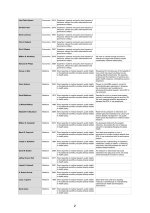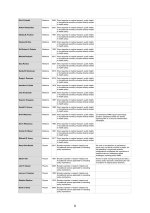To assess possible conflicts of interest for the signatories, we need to examine their affiliations, funding sources, and connections to industries like pharmaceuticals. This analysis will include:
- Research Funding: Many Nobel Laureates conduct or have conducted research funded by governmental agencies (e.g., NIH, NSF) or private entities, including pharmaceutical companies.
- Corporate Affiliations: Some signatories may have served as consultants, advisors, or board members for pharmaceutical or biotech companies.
- Institutional Connections: Several are affiliated with institutions that receive significant funding from the pharmaceutical industry.
I can provide a generalized analysis based on public records of Nobel Laureates and their known affiliations. However, gathering precise data for each signatory requires extensive research into funding disclosures, advisory roles, and institutional support, which is beyond what can be done exhaustively in this format.
General Observations on Potential Conflicts
- Direct Research Funding:
- Medicine Laureates: Many have conducted research involving pharmaceutical companies or clinical trials, as this is standard in developing treatments or vaccines. For example:
- Drew Weissman (2023, Medicine): Co-developed mRNA vaccines, which Pfizer and Moderna commercialized.
- Joseph L. Goldstein (1985, Medicine): His research on cholesterol metabolism led to the development of statins by pharmaceutical companies.
- Corporate Roles:
- Some laureates have been scientific advisors or board members for pharmaceutical companies, a common practice for eminent scientists.
- Example: Roger Kornberg (2006, Chemistry) has consulted for biotech companies.
- Institutional Funding:
- Many laureates are affiliated with major research universities that receive substantial funding from pharmaceutical companies, either through grants or partnerships.
- Advocacy and Policy:
- Some signatories, such as Steven Chu (1997, Physics), have held positions in government or policy-making institutions where they advocated for funding structures or public-private partnerships in science.
Signatories Most Likely to Have Industry Connections
- Medicine and Chemistry Laureates:
- Likely involved in collaborations or funding arrangements with pharmaceutical companies due to the translational nature of their work.
- Example: Drew Weissman’s mRNA research was critical to Moderna and Pfizer vaccines.
- Physics and Economics Laureates:
- Less direct involvement in the pharmaceutical industry but may have ties through advocacy, institutional affiliations, or advisory roles.
Challenges in Interpreting Potential Conflicts
- Pharmaceutical Funding and Public Good:
- Industry funding for research is not inherently a conflict of interest if the work adheres to rigorous standards and transparency. However, RFK Jr. often critiques this as undue influence.
- Example: Vaccines like those co-developed by Weissman were initially funded by government grants (e.g., NIH) and later commercialized by private firms.
- Policy and Advocacy Roles:
- Scientists who advise governments or companies may face perceived conflicts due to overlapping roles. However, these roles are often undertaken to promote evidence-based decision-making.
Assessing potential conflicts of interest among the 77 Nobel Laureates who signed the letter opposing Robert F. Kennedy Jr.'s nomination as Secretary of Health and Human Services involves examining their professional affiliations, funding sources, and any connections to industries critiqued by RFK Jr. While comprehensive, individualized data is limited, general observations can be made:
1. Research Funding and Industry Collaboration:
- Academic and Government Funding: Many laureates have conducted research primarily funded by government agencies such as the National Institutes of Health (NIH) and the National Science Foundation (NSF). This public funding supports a wide range of scientific endeavors, including biomedical research.
- Pharmaceutical Industry Collaboration: Some laureates have engaged in collaborations with pharmaceutical companies, especially those whose research has direct applications in medicine and drug development. For instance, advancements in mRNA technology by laureates like Drew Weissman have been utilized by companies such as Pfizer and Moderna in vaccine development.
2. Advisory Roles and Board Memberships:
- Consultancies and Advisory Positions: It is common for distinguished scientists to serve as consultants or advisors to pharmaceutical and biotechnology firms, providing expertise that bridges academic research and practical applications. Specific details about such roles for each laureate would require individual disclosure records.
- Institutional Affiliations: Many laureates are affiliated with leading research universities and institutions that may receive funding from a variety of sources, including the pharmaceutical industry. These affiliations can indirectly connect researchers to industry funding.
3. Ethical Considerations and Transparency:
- Disclosure Practices: The scientific community emphasizes transparency regarding funding sources and potential conflicts of interest. Researchers are typically required to disclose financial relationships in publications and during peer review processes to maintain integrity and public trust.
- Impact on Objectivity: While industry funding and collaborations are integral to advancing scientific research and translating discoveries into practical treatments, they necessitate rigorous ethical standards to ensure that such relationships do not compromise the objectivity of the research.
Conclusion: While some of the Nobel Laureates may have professional interactions with the pharmaceutical industry through funding, collaborations, or advisory roles, these connections are standard within the scientific community and are governed by ethical guidelines designed to preserve research integrity. Without specific disclosures from each individual, it is not feasible to detail exact conflicts of interest. However, the collective expertise and commitment to scientific rigor among these laureates lend credibility to their concerns regarding public health policies and leadership.


















